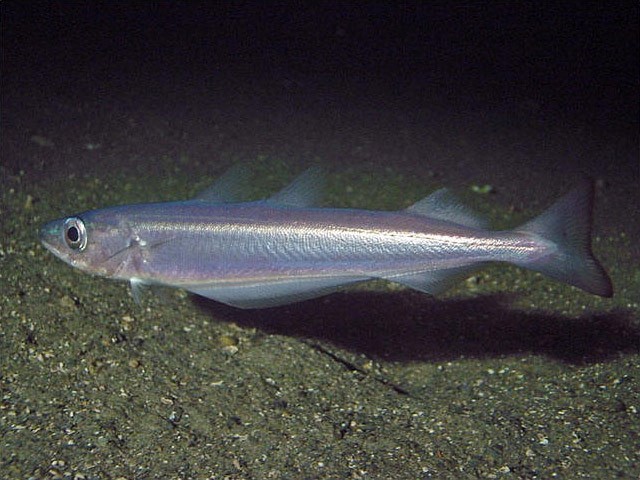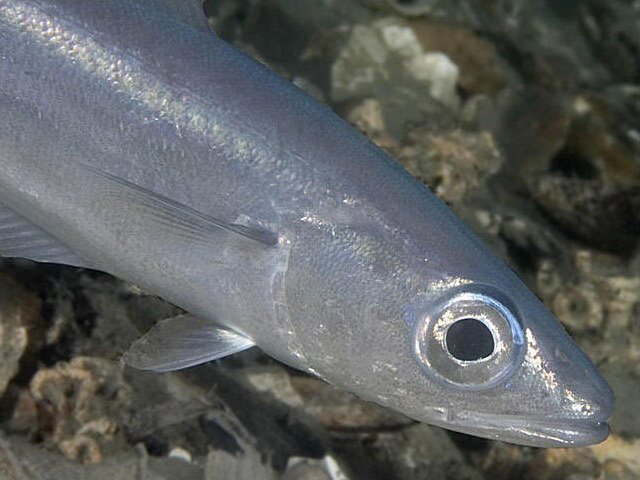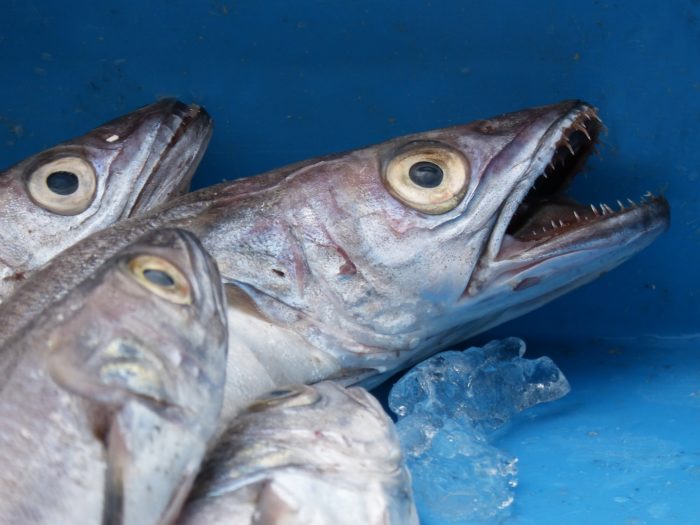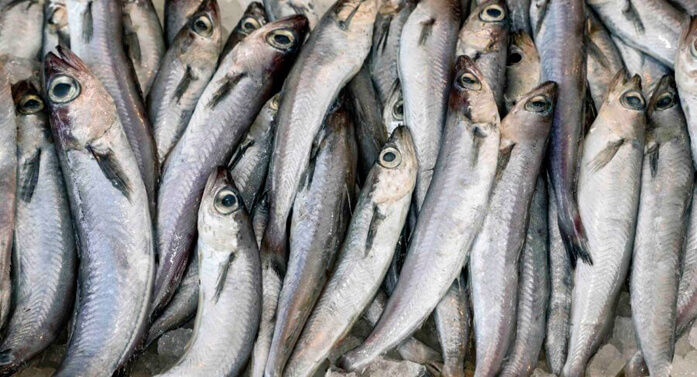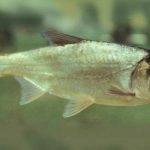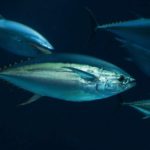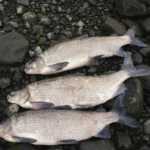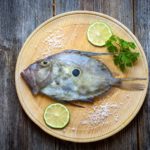Lean marine fish, such as small members of the cod family (such as whiting), are considered an important part of the nutritious diet and are often included in the diet menu. To better understand the advantages and disadvantages associated with this type of fish, it is worth considering its general characteristics, taking into account the advice of nutritionists on its consumption, as well as useful life hacks for purchasing and storing.
Description of the species
The cod family, which includes blue whiting, is one of the largest families of fish. It includes about 300 species.They are widespread and are found in all oceans of the world, from shallow coastal areas to deep-sea reefs.
The subspecies of cod Micromesistius (another name is blue whiting) is in great demand in the fishing industry. Blue whiting ranks fifth in terms of catch among all commercial fish varieties, which makes it a frequent “guest” on the tables of sea fish lovers.
What does a fish look like?
Blue whiting is a type of small sea fish that can grow up to 18-38 centimeters in length, and the most “massive” specimens reach a weight of one kilogram. There are two branches of this genus - northern and southern. It should be noted that the southern variety of whiting is, as a rule, larger than the northern one.
The fish looks scary with its large head and protruding eyes, but is actually harmless. At the same time, silvery scales and three dorsal fins give it an elegant appearance. As for taste, blue whiting meat is dense and white, which makes it comparable to hake meat in taste.
Diet
Blue whiting is a completely harmless fish that consumes crustaceans, eggs of other fish such as herring and cod, and luminous anchovies. And if there is not enough food during the changing seasons, she will gladly switch to cephalopods that are found near her habitat.
This silvery fish remains a favorite food source for large marine mammals such as dolphins and killer whales.
Where does she live
Micromesistius is commonly found in cool Atlantic and Pacific waters. Far from being a tropical inhabitant, this species of cod prefers to live in cold areas.
Given the preferences of blue whiting, which live at deep ocean levels, fishermen use bottom trawls to catch this species of cod in large quantities.Fortunately, such a massive harvest does not pose a threat of complete extinction, since the world's stocks and breeding grounds are under the supervision of nature conservation specialists.
Features of meat
The meat of this sea fish has a number of features that distinguish it from the meat of other aquatic inhabitants:
- Rich in protein. Fillet contains a significant amount of protein, which is considered the main building material for the cells of the human body. At the same time, the protein in Micromesistius meat is of high quality, as it contains all the amino acids necessary for humans.
- The meat is lean. Fillet contains very little fat, which makes it a dietary product. This is an ideal choice for people who care about their health.
- Contains essential microelements. Blue whiting contains: iodine, phosphorus, calcium and selenium. They are vital for the normal functioning of the body.
- Tender meat. The consistency of the fillet is soft, without a strong fishy smell, which makes it pleasant to the taste and easily digestible.
- Light meat, suitable for cooking in all possible ways.
Blue whiting is a prime example of a product for a middle-class kitchen. Professional chefs value its availability and usefulness as an alternative to cod. The good thing about this fish is its versatility; it goes well with a variety of ingredients, and spices perfectly reveal its taste.
It is important to remember that this fish should not be eaten with legumes (reviews regarding this combination are very negative). However, it is not uncommon for people to have different preferences when it comes to food.
When it comes to preparation, it is important to remember that blue whiting is easy to process. It is easy to boil, bake or fry; you can even pickle or dry it. The flesh of this fish easily “forgives” culinary mistakes, although the carcass itself contains a lot of bones. If blue whiting is part of your diet, consider using a steamer. Steamed Micromesistius is a great option for those watching their weight.
Keep in mind that the meat of this fish, although firm, will lose its appearance - it will fall apart if you cook it for too long. Keep this in mind and keep track of the time spent preparing it.
Calorie content
Micromesistius meat is low in calories and is considered a valuable source of proteins and beneficial microelements.
For 100 grams of meat of this sea (not river) fish there is approximately:
- Calorie content: 80 kcal.
- Proteins: 15-18 g.
- Fat: 1.1 g.
Blue whiting is not a high-fat variety; its fat content is less than 1%. However, it is important to note that Micromesistius liver contains large amounts of animal fat. Carcasses are usually very lean and are well absorbed by the body.
Useful and harmful properties
This seafood is useful because it is digested quickly, usually within two hours, which is very different from the time it takes for the body to assimilate pork or beef.
This inconspicuous-looking fish has a number of beneficial effects on human health, such as:
- strengthening the immune system, making the consumer immune to fatigue and able to withstand difficult working conditions;
- stimulating cerebral circulation, improving memory and preventing atherosclerosis, as well as strengthening blood vessels;
- Helps remove metabolic by-products from the body and eliminate toxins;
- lowering cholesterol levels;
- Helps in weight loss due to high protein content combined with low calorie content;
- slowing down aging;
- acceleration of wound healing;
- improved vision;
- increased metabolic rate;
- strengthening the nervous system;
- improving the appearance and texture of skin/hair;
- regulation of cholesterol levels;
- promoting the production of sex hormones;
- participation in the formation of blood cells;
- protection from disturbances in the functioning of the reproductive organs;
- Help for healthy fetal development during pregnancy.
Blue whiting liver is especially beneficial for both sexes due to its Omega-3 fatty acid content. These PUFAs help regulate hormones, improve the appearance of skin, hair and nails, reduce the risk of joint problems and support heart and blood vessel health.
100 grams of blue whiting meat contains the following vitamins, micro- and macroelements:
- Calcium: 20 mg.
- Magnesium: 22 mg.
- Potassium: 360 mg.
- Phosphorus: 270 mg.
- Iron: 0.5 mg.
- Sodium: 55 mg.
- Zinc: 0.5 mg.
- Vitamin A: 20 mcg.
- Vitamin E: 0.2 mg.
- Vitamin B1 (thiamine): 0.02 mg.
- Vitamin B2 (riboflavin): 0.06 mg.
- Vitamin B6: 0.2 mg.
- Vitamin B12: 1 mcg.
- Niacin: 1.8 mg.
- Pantothenic acid: 0.3 mg.
- Folic acid: 3 mcg.
- Iodine: 110 mcg.
The only reason not to eat whiting dishes is if someone has an individual intolerance to it. People prone to allergic reactions should exercise caution when they decide to include this fish in their diet. It is best to consume no more than 250 grams of fish per day and regularly check for any reactions or side effects.
There is no scientific evidence to support speculation that eating sea fish leads to cancer. There is no established connection between cancer and blue whiting.
However, do not forget about the risks of parasite infection. Blue whiting is often mentioned in medical reports due to the presence of helminths and other harmful organisms. This species is difficult to sort due to its small size, which makes it difficult to decide which specimens are contaminated and should be removed from sale.
Carefully inspect the belly and entire body of the fish - if you see anything that looks questionable, do not consume the product. High temperatures and freezing fish should theoretically destroy any dangerous organisms, but it is still unwise to put your health at risk.
Who can eat fish
This fish of the cod family is edible and very tasty. Both adults and children are allowed to eat it. It contains a lot of protein, iron, phosphorus, iodine, selenium, calcium, potassium, essential fatty acids and vitamins B12 and D. All these elements are necessary to maintain human health. However, as with any fish, you should be careful and make sure it is fresh and cooked correctly.
Adults
Adults are recommended to eat blue whiting; it is safe for health and even beneficial due to the beneficial nutrients it contains.
This fish is high in protein and low in fat, and is also considered a good source of vitamins and minerals such as vitamin B12, phosphorus and selenium. Research has shown that blue whiting even has anti-inflammatory properties due to its Omega-3 fatty acid content, which helps reduce inflammation in the body.
However, it should be remembered that blue whiting sometimes contains a certain amount of accumulated mercury, depending on where it is caught. This amount can be harmful to health if fish is consumed in large quantities. Overall, blue whiting is a healthy and nutritious food if eaten in moderation and no more than once or twice a week.
This fish is very useful for older people. The ability of this fish to treat problems of the musculoskeletal system will come in handy. It helps reduce excess fluid in the joints and is considered an effective way to minimize rheumatic pain. In addition, eating its meat helps older people improve brain function and improve cardiovascular health.
Children
Blue whiting is offered as a nutritious food for children. Potassium helps the cardiovascular system, phosphorus improves cognitive performance, and iodine helps the thyroid gland. This is a type of fish with a scientifically proven beneficial effect thanks to various studies. Generally accepted recommendations state that blue whiting should be consumed by children from the age of three.
Care must be taken when preparing dishes for children from this low-calorie sea fish, as it contains many small bones. It is important to ensure that the child does not swallow the bone.
It is important to be aware of potential seafood allergies and remember that blue whiting is susceptible to parasites. Before purchasing for cooking, it is important for children to check the quality of the product.
Pregnant
Numerous studies have demonstrated the benefits of eating this fish for expectant and nursing mothers. Animal fats in combination with iodine are considered especially useful in this regard.An inexpensive and convenient way to provide the body of a mother and her child with these benefits is by eating blue whiting.
Blue whiting is highly recommended as part of the diet of nursing mothers due to its low calorie content and virtually no side effects. Including fish in the daily diet will help in the development of the child's immune system (thanks to iodine) and skeletal structure (thanks to calcium).
Obese people
Boiled blue whiting is an ideal source of protein for weight loss diets. This fish is an excellent choice for those who prioritize sports and a healthy diet, as it contains very few calories, but at the same time provides high levels of protein, phosphorus and iodine. When planning to switch to a special diet to combat obesity, it is important to consider the unique benefits that blue whiting offers.
How to select and store
Recommendations for choosing fish are simple:
- carefully inspect the carcass, fins and tail to ensure that the product is in good condition;
- examine the eyes carefully to make sure they are clear;
- smell the product - if it has a disgusting smell, then it is definitely stale;
- check that the fillet is firm.
Raw fish must be stored at a temperature of 0 to +2 degrees Celsius, in the refrigerator or in a special chamber for storing seafood. Raw meat can be stored in the refrigerator for up to 2-3 days, depending on the freshness of the carcass. To increase the shelf life of raw fish, it should be frozen. To do this, the carcass must be cut into portions and packaged in cling film or freezer bags, and then placed in the freezer at a temperature of -18 degrees Celsius. Frozen fish can be stored for up to 6 months.

